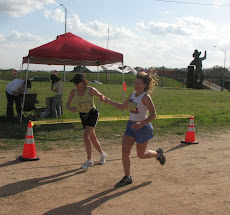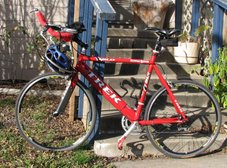Negative Splits
Late Summer, will the heat ever begin to diminish? Let's hope the day dawns cool soon so we can all kick up our heels and raise hossanas that we trained through the South Texas summer and lived to tell about it. Let's start the final countdown to the San Antonio Rock'n'Roll Marathon and start racing.
Truth is, I'm not much of a racer. I generally don't care who passes me or who I pass, though I did grieve for a short while a few weeks ago when a young kid finished ahead of me at the Fleet Feet Sunrise 10K. Nevertheless, I was happy with my own performance on what was a challenging and hilly course. I exceeded my expectations and that's always good. More important than the finishing time of 62 minutes (I told you I'm not much of a racer!) was the negative split. My intentions had been to run at my marathon pace of around 11 minute miles, but I found at the 3 mile mark that my pace was about 10:10. In order to realize my second intention for this race, a negative split, I decided to carry on the 10:10 pace, and even to pick it up ever so slightly. Amazingly, I was able to execute it and run the second half of the race slightly faster than the first half.
As I have grown more experienced in distance running, I have come to appreciate establishing goals in more complex ways. By this, I mean I will run a race, or a workout, with more than just getting from point A to point B in such and such amount of time as my goal. Perhaps I will run with my heart rate monitor and allow that to dictate my pace. This allows me to tailor the run for maximum benefit. Don't get me wrong, I am still learning how to use these various tools and techniques. Nevertheless, I believe in the science of acheiving fitness, and a heart rate monitor is a great benefit. For that matter, I have often run marathons wearing the monitor and this has helped me keep my pace in check. Alas and alack, I still haven't managed a marathon in a negative split, even with the heart rate monitor reminding me to slow down in the early going.
So....are you running one of the Fall marathons, maybe the inaugural R'n'R San Antonio Marathon? If so, why don't you try binding together several different goals in order to improve your opportunity for success? Here's my set of goals, really not much more complicated than a wish to finish in under 5 hours, but with a strategical element of running a negative split. What is a negative split? It is simply running the second half of a race (or a workout run) in less time than it took to run the first half. Mostly, this just makes the runner aware of not getting caught up in the buzz of the crowd (and, if the organizers are successful, the numerous bands which will be entertaining along the marathon course). Don't go out too fast, that's what I will be reminding myself. Yes, we have to listen to our bodies, but also we have to strategize a pace which will allow for a negative split. There are numerous online calculators for doing this, so let's ignore the specifics of the math; it's going to be different for everyone, anyhow; many of you will run faster than I.
The negative split is something I never thought about the first couple of times I ran marathons. I don't think I even knew the concept. So, take it from me, or from the example of those smart runners who succeed at their time goals because of attention to negative splits, use your smarts and strategize for success. I hope to see you at the finish line grinning ear to ear with the satisfaction of making our finishing goals, and doing it with a negative split.










